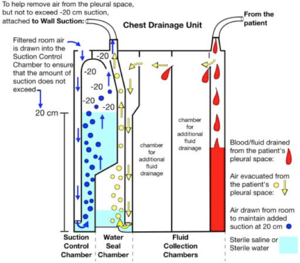
CHEST TUBE BASICS[edit | edit source]
[edit | edit source]
- Sanguineous- is fresh thick blood.
- Serosanguineous- is thin, like water. It usually has a light red or pink tinge, though it may look clear in some cases. Its appearance depends on how much clotted red blood is mixed with serum.
- Serous- a clear to pale yellow watery fluid
- Chylous – has a milk like appearance. Chylothorax is a rare condition in which lymph formed in the digestive system (chyle) accumulates in your chest cavity. Lymph is a fluid containing white blood cells and proteins that moves through your lymphatic system and drains into your bloodstream
Trouble Shooting[edit | edit source]
- Accidental removal
- Occlude the site ASAP!
- Cover the hole with a gloved hand until you can apply Vaseline gauze/dry gauze/tegaderm
- This is where your emergency chest tube kit comes in handy
- Get a STAT Chest X-ray
- Watch for signs of pneumothorax
- Respiratory Distress
- Consider O2 support if needed
- Surgery will decide if need to be replaced
- Airleaks
- Water Seal Chamber
- Acts as one-way valve so air can get out of the chest, but not back in
- Fluctuations in the water level and bubbling provides an indication of intrathoracic pressure
- The water in the water-seal chamber should rise with inhalation and fall with exhalation (this is called tidaling)
- Bubbling in chamber in this chamber is called an “air-leak” and indicates either evacuation of air from the chest or a leak in the system
- Continuous bubbling in the bottom of the water-seal chamber from right to left should lead to suspicion of an air leak in system
- Location
- Is the air coming from the patient or from a crack in the system?
- Clamp CT close to the patient if no air leak in water seal chamber, then patient is evacuating air from chest
- May have flute or fenestration outside pleural cavity (may cause noise)
- Clamp CT close to patient, if air leak still present in water seal chamber- air is coming from a crack in the system
- Try replacing the Atrium
- Air leaks are often more apparent when a patient coughs
- Chest tube removal supplies and how to (usually by MD)
- Assess for air leak
- Remove from suction
- Prepare dressings (Vaseline gauze, standard gauze, tegaderm)
- Remove old dressing
- Remove anchor suture (typically a black suture)
- If purse string is present (typically a white suture), ensure both ends are free and suture is intact
- Cover exit site with Vaseline gauze and standard gauze
- Chest tubes should be removed at the end of inspiration or beginning of expiration to avoid sucking air into the chest
- Remove chest tube quickly at end of inspiration or expiration.
- Keep exit site covered
- Tie down purse-string suture (if present) without pulling too tightly (to avoid tissue necrosis)
- Obtain a CXR ~1hr post chest tube removal – order sooner if patient becomes clinically unstable